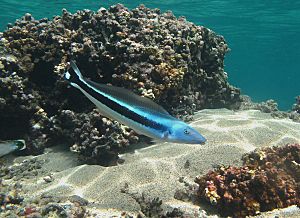Blue blanquillo facts for kids
Quick facts for kids Blue blanquillo |
|
|---|---|
 |
|
| Conservation status | |
|
Not evaluated (IUCN 3.1)
|
|
| Scientific classification | |
| Kingdom: | |
| Phylum: | |
| Class: | |
| Order: | |
| Family: |
Malacanthidae
|
| Genus: |
Malacanthus
|
| Species: |
M. latovittatus
|
| Binomial name | |
| Malacanthus latovittatus (Lacépède, 1801)
|
|
| Synonyms | |
|
|
The blue blanquillo (Malacanthus latovittatus, also known as the banded blanquillo, striped blanquillo, false whiting, sand tilefish or eye of the sea) is a species of tilefish. It is one of the many members of the family Malacanthidae. It is the only species within the genus Malacanthus.
Description
Fish from the family Malacanthidae have streamlined bodies and large crests on their head. They have relatively long dorsal fins and anal fins. The blue blanquillo gets its name from its mainly blue colour. It also has some shades of yellow, and can change colour in different situations. On their backs, there is a set of stripes that run across its body. Their belly is white. The colour of the head changes from a light blue to a pinkish mix during spawning season.
Where they live
Blue blanquillo fish are usually found in the Indo-Pacific area. They live anywhere from the Red Sea to the Line Islands, north to southern Japan and south to New Caledonia and the Cook Islands. They are often seen in areas around coral reefs near the sea floor.
Behaviour
Malacanthus latovittatus does not swim in groups. They are often found swimming alone or two together. They are known to clean other fish. They also mimic the wrasse to stop predators from eating it.
The fish can swim at depths of 20–22 metres (66–72 ft). The temperatures of the water it swims in normally range from 22–28 °C (72–82 °F). They tend to swim high above the floor of the sea. This is so that they can pick prey from the ground with their eyesight, which is very good.
Ecology
The blue blanquillo's main staple are the invertebrates or zooplankton that live near the bottom of the sea. They also eat crustaceans such as crabs and shrimp, molluscs, worms, sea urchins and small fish. Their common predators are reef sharks, and other larger fish. They are also eaten by humans.
Images for kids


